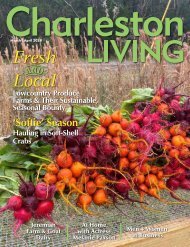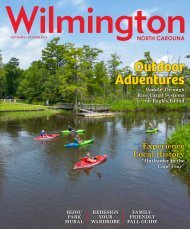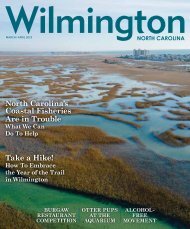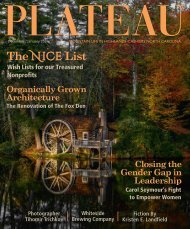Plateau Magazine Feb/Mar 2021
This issue we feature some great home renovations, and interview with the resort (and dog friendly) The Park on Main. We also feature our annual roundup of non-profit fundraising groups and showcase local wedding vendors to help plan your big day.
This issue we feature some great home renovations, and interview with the resort (and dog friendly) The Park on Main. We also feature our annual roundup of non-profit fundraising groups and showcase local wedding vendors to help plan your big day.
Create successful ePaper yourself
Turn your PDF publications into a flip-book with our unique Google optimized e-Paper software.
Kids In The Creek with Mainspring<br />
Conservation Trust; (right) Trout Unlimited<br />
improving our waterways<br />
Invasive, nonnative plants also pose a<br />
threat. Kudzu, a plant we are all familiar<br />
with, grows quickly and can cause a<br />
fair amount of destruction. “[Kudzu] ...<br />
prevents oaks from producing acorns. A<br />
hillside overtaken with kudzu basically<br />
eliminates the habitat for species in the<br />
area,” says Paige Engelbrektsson, the<br />
nature center education specialist for the<br />
Highlands Biological Station. Engelbrektsson<br />
urges homeowners to commit to only<br />
using native plants in their landscapes,<br />
and if a manageable invasive species such<br />
as English ivy is present, to work towards<br />
eliminating it as best they can. Kudzu,<br />
however, is far too prolific to battle alone,<br />
and that is where an organization such as<br />
the Coalition for Nonnative Invasive Plant<br />
Management proves highly beneficial to<br />
the community.<br />
Using native plants not only helps combat<br />
issues from their nonnative counterparts,<br />
but it creates a healthier, thriving<br />
population of pollinator insects. “The<br />
thing about nonnative plants,” says Kyle<br />
Pursel, “is it’s kind of like junk food...some<br />
have no nutrients at all.” Caring for the<br />
land and protecting species such as our<br />
giant eastern hemlocks to the smallest<br />
wildflowers that feed our butterflies and<br />
honeybees impacts all other types of wildlife<br />
in our area.<br />
Caring for Our Waterways<br />
Our picturesque lakes, rivers, streams<br />
and waterfalls attract all kinds of people,<br />
from hikers and photographers to avid<br />
anglers—and keeping those waterways<br />
clean is a never-ending task for many<br />
groups and organizations. Two local retailers,<br />
Headwaters Outfitters and Brookings<br />
Anglers, take the health and vitality<br />
of the plateau’s waterways very seriously.<br />
“One of our biggest concerns is roadside<br />
trash,” says Jessica Whitmire, operations<br />
and marketing manager for Headwaters<br />
Outfitters.<br />
Teaming with other local businesses,<br />
Headwaters Outfitters has sponsored<br />
a major clean-up project on the upper<br />
French Broad River annually for over 30<br />
years and have since removed over 15 tons<br />
of trash, including hundreds of old tires<br />
and even the occasional mattress and box<br />
springs. “We are thankfully seeing less<br />
historical trash,” Whitmire says. “It is<br />
getting better, but there is always room<br />
for improvement. We can all step it up a<br />
little more.” Whitmire does not believe<br />
most people litter on purpose. Instead, the<br />
bulk of what is seen now comes from improperly<br />
secured garbage or has escaped<br />
vehicles when doors are opened—accidental<br />
culprits from well-intentioned people.<br />
Unfortunately, there are still some who<br />
do not utilize garbage cans when visiting<br />
our parks and scenic spots, which adds<br />
additional work for staff and volunteer<br />
groups—and much of it ends up in our<br />
waterways.<br />
Matt Canter, owner of Brookings Anglers,<br />
agrees, although it isn’t only garbage<br />
he wants people to consider. Beneath<br />
the surface of the water is a complicated<br />
and fragile ecosystem that not only benefits<br />
tremendously from getting rid of the<br />
obvious pollution, but needs special consideration<br />
during property development,<br />
and it starts with healthy insect populations.<br />
Stoneflies, for example, spend 99%<br />
of their life cycle underwater, and they<br />
need the rocky river bottom to survive.<br />
Silt runoff from development sites can<br />
travel for miles downstream before it settles<br />
over these rocks, potentially disrupting<br />
the stonefly, a major food source for<br />
our beloved trout.<br />
“And the trout need the rocks to lay<br />
eggs, as well,” says Canter, making the<br />
degradation of rocky river bottoms doubly<br />
troublesome for one of the area’s most<br />
iconic and popular fish: the brook trout. To<br />
further complicate matters, along some of<br />
our riverbanks we’re inadvertently raising<br />
the temperature of the water as well.<br />
“[Trout] need cool water,” Canter says,<br />
specifying 70-degrees or below. “When we<br />
PHOTO MAINSPRING CONSERVATION TRUST<br />
64 | The<strong>Plateau</strong>Mag.com

















